Abstract
Epiphytes are a group of plants that grow on citrus by using the trees for anchorage and support. These plants are not in direct contact with the ground and obtain moisture and nutrients from the air and rainfall. Epiphytes make up an essential part of biodiversity in citrus groves and these plants present no threat to the citrus trees.
Introduction
The thousands of acres of citrus groves in Florida provide an environment for many epiphytic plant species. "Epiphytic" is a Greek term meaning "on the plant," and is most commonly used to describe plants growing on trees and shrubbery. Epiphytes growing on trees are also referred to as "air plants" because they have no physical contact with the land. Epiphytic plants are an important addition to biodiversity; however they are often incorrectly considered as weeds among agricultural tree crops, including citrus in wet and humid areas. Nevertheless, these plants do not harm their host trees, as none of them are parasites. These epiphytes use their host trees for support. Moreover, these epiphytes play some essential ecological roles, both in nutrient recycling and in creating a unique habitat resource for birds and insects (Caldwell, 2007). Many epiphytes are listed as threatened or endangered and should be protected.
Epiphytic plants found on Florida citrus can be classified into three broad categories:
- Tillandsias (or bromeliads), members of the pineapple family
- Orchids
- Nonflowering plants (ferns, true mosses, and lichens)
Vines are not listed among the epiphytes, as they are terrestrial (ground-growing) in origin.
Tillandsias
There are five major species of Tillandsia found in citrus groves. These flowering plants are commonly referred to as "bromeliads" and are all members of the pineapple family (Bromeliaceae). These plants use their hosts for anchorage and support. Also, there has been no evidence of these species acting as a host for citrus pests or pathogens. The major Tillandsia species found on citrus, two of which are endangered species, are as follows:
Spanish moss (Tillandsia usneoides) is a flowering plant, not a moss, as its name suggests. The half-inch-length tubular flowers are purple and the plant flowers throughout the year. Of all the epiphytic plants, this species is the most pronounced and the colonies of this plant grow prolifically on citrus trees.

Credit: Mongi Zekri, UF/IFAS
Ball moss (Tillandsia recurvata) is, again, not a moss. This close relative of Spanish moss is found growing in spherical balls on vast array of anchor structures ranging from host plants, such as citrus trees, to electric utility wires. Although not as prolific as Spanish moss, large colonies may occasionally be seen on citrus and other host species.
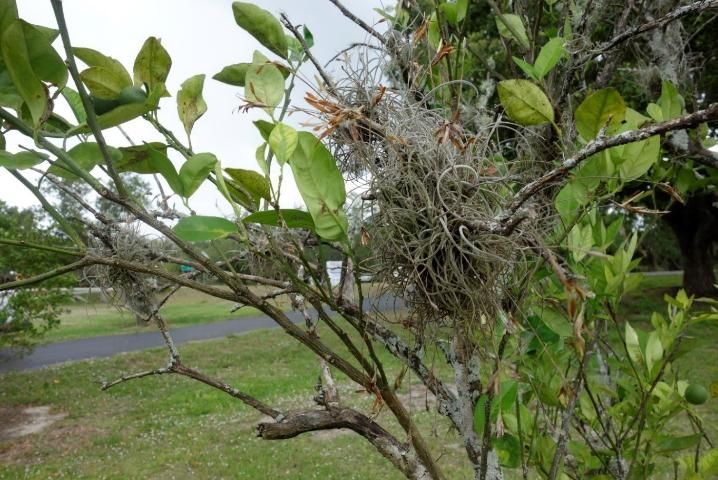
Credit: Mongi Zekri, UF/IFAS
Bartram's airplant (Tillandsia bartramii) is also found extensively throughout Florida's citrus- growing regions. This plant grows on a variety of hosts and has also gained popularity among ornamental plant enthusiasts.

Credit: Mongi Zekri, UF/IFAS
Wild pine (Tillandsia utriculata) is the largest of Florida's native bromeliads, with the inflorescence growing up to six feet in height. The plant is also exceptionally long-lived on host trees, causing no affliction to its host. Wild pine is considered an endangered species and should be protected (Larson et al. 2004). For more information, refer to 'Florida's Native Bromeliads' at https://edis.ifas.ufl.edu/uw205.
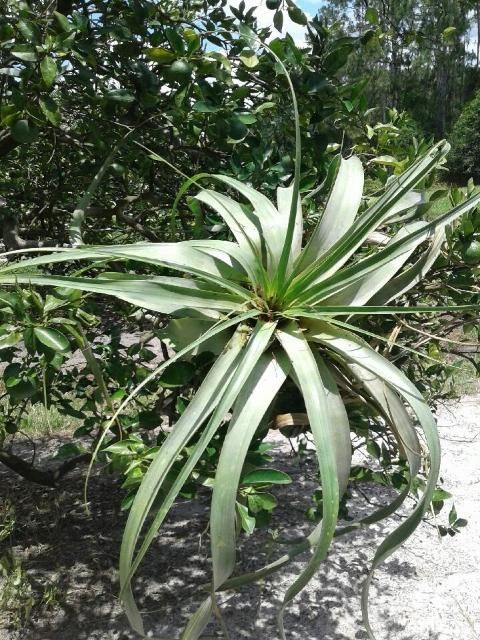
Credit: Robert Riefer
Cardinal plant (Tillandsia fasciculata) has an inflorescence that produces an attractive red color in strong sunlight, hence its name. Large clumps may be observed in a wide variety of host trees, including citrus. Colonies of this bromeliad represent no threat to their hosts. Cardinal plant is considered endangered and should be protected (Larson et al. 2004) For more information, please refer to 'Florida's Native Bromeliads' at https://edis.ifas.ufl.edu/uw205.

Credit: Robert Riefer
Orchids
Orchids are another category of common epiphytes on citrus trees. They are most prevalent in the citrus-growing regions that receive high rainfall. These orchids have no harmful impacts on their hosts. Of the hundreds of species of orchids in Florida, two species of orchids, the butterfly orchid and the jingle bell orchid, have been commonly found in both abandoned and well-maintained groves.
Butterfly orchid (Encyclia tampensis) is named after the Tampa Bay area where it was first discovered and is ubiquitous in the state of Florida. This plant grows in an assortment of host trees and plants, as well as terrestrially in rocky areas filled with leaf litter. This orchid has been commercially exploited, and therefore needs to be protected.

Credit: Julie Carson, UF/IFAS
Jingle bell orchid (Harrisella porrecta) is named after the tiny seed pods this orchid produces, which turn orange-brown when mature. It is one of the species of "leafless" orchids. The seedlings produce only one to two leaves when germinated, which are quickly shed as the plant matures. This orchid is currently listed as a threatened plant.

Credit: Roger Hammer, UF/IFAS
Nonflowering Plants
Nonflowering plants are the third category of epiphytes found on citrus trees. These plants include ferns, true mosses, and lichens. As with the other major groups of epiphytes, these plants utilize the host trees only for a foothold and are not parasitic.
Resurrection fern (Pleopeltis polypodioides) appears dead and dehydrated during periods of dry weather, but springs to life with even a brief rainfall. As with all of the epiphytes above, there is no evidence that this species harbors any harmful pests or pathogens to citrus.
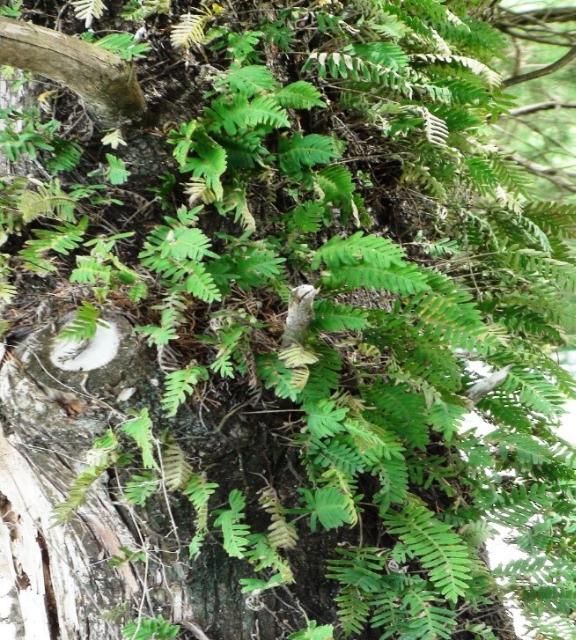
Credit: Julie Carson, UF/IFAS
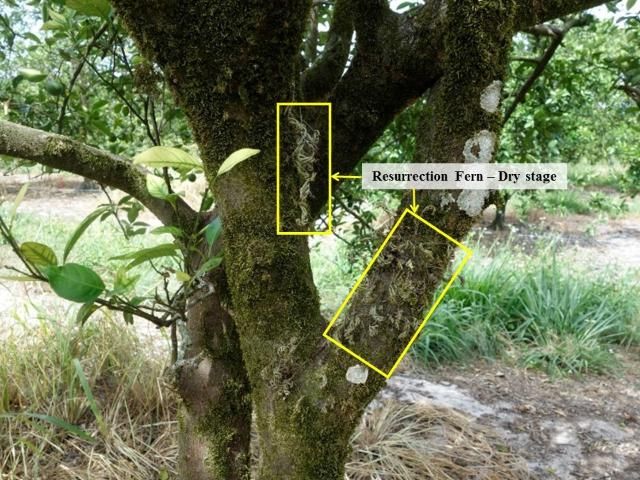
Credit: Mongi Zekri, UF/IFAS
True mosses (several genera and species) are predominantly found growing on mature citrus groves where the dense tree canopy provides a shaded, low-light environment. True mosses do not grow well in open exposure to full sunlight.
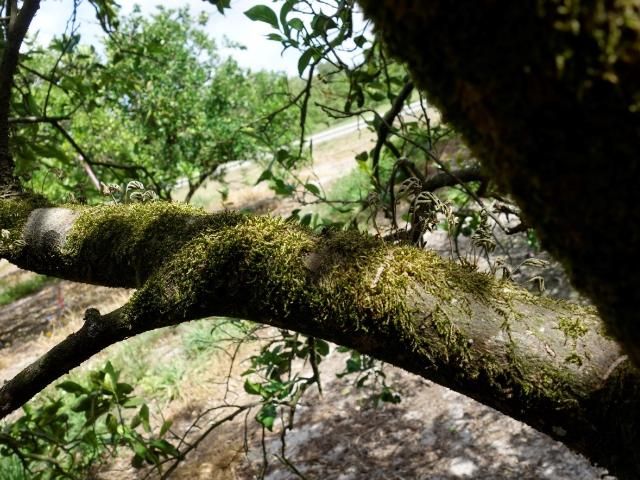
Credit: Mongi Zekri, UF/IFAS
Lichens (several genera and species) appear as circular-to-elliptical patches on the trunk, branches, and twigs of the citrus trees. Lichens are not a single plant, but two organisms: a fungus and algae in a symbiotic relationship. The algae provide the fungus with food, and the fungus provides the attachment and anchorage, as well as absorption of water and nutrients from the surface layer of bark or leaves where the lichen grows. Old or diseased citrus trees appear to have more lichens than healthy ones, as the bark of weak trees is more conducive to fungal growth.

Credit: Mongi Zekri, UF/IFAS
Summary
Epiphytes make up an essential part of biodiversity in citrus groves. Control of the aforementioned epiphytic plants in citrus groves is unwarranted, as these plants present no threat to their host trees. Because many groves are routinely sprayed with copper to kill pathogens, such as citrus canker, these epiphytes are unable to gain a foothold in citrus groves. Bromeliads are susceptible to high copper doses. Lichens are also affected by copper compounds.
Additional Information
Many epiphytes are listed as threatened or endangered and should be protected. Before removing or destroying any epiphytic plants, consult the list of Florida's regulated plant species (http://www.flrules.org/gateway/ruleno.asp?id=5B-40.0055&Section=0). Florida law (Section 581.185, Florida Statutes) prohibits the removal of any endangered plant without both written permission of the land owner or custodian and a collecting permit issued by the Division of Plant Industry.
If a grove owner desires to rescue these epiphytic plants from their citrus trees, it is recommended that one of the following groups or societies be contacted for information on their proper relocation.
- Save Florida's Bromeliads Conservation Project (sfbcp@savebromeliads.com)
- Local bromeliad societies (e.g., Caloosahatchee Bromeliad Society - Ft. Myers, Sarasota Bromeliad Society, Bromeliad Guild of Tampa Bay)
- Florida Native Plant Society (www.fnps.org)
For more information on bromeliads please visit 'Save Florida's Native Bromeliads'- A Project of the Florida Council of Bromeliad Societies and the UF/IFAS at http://entomology.ifas.ufl.edu/frank/savebromeliads/
For more information on orchids, please visit "Florida's Native and Naturalized Orchids" at http://www.flnativeorchids.com/
Also, for further information, please contact the Master Gardeners associated with your local UF/IFAS Extension office.
Acknowledgements
We are indebted to Dr. J.H. Frank, Dr. P. Anderson and Dr. M.B. Main for their expertise and guidance during the preparation of this article.
References
Caldwell, D. 2007. "Ball Moss–Free Bromeliads". Naples Daily News. Feb. 24, 2007.
Larson, B; Frank, J.H; Main, M.B and Allen G.M. 2006. Florida's Native Bromeliads. CIR1466. Gainesville: University of Florida Institute of Food and Agricultural Sciences. https://edis.ifas.ufl.edu/uw205